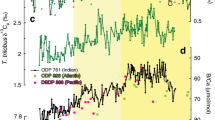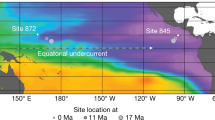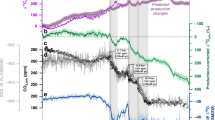Abstract
Over the past three million years, Earth’s climate oscillated between warmer interglacials with reduced terrestrial ice volume and cooler glacials with expanded polar ice sheets. These climate cycles, as reflected in benthic foraminiferal oxygen isotopes, transitioned from dominantly 41-kyr to 100-kyr periodicities during the mid-Pleistocene 1,250 to 700 kyr ago (ka). Because orbital forcing did not shift at this time, the ultimate cause of this mid-Pleistocene transition remains enigmatic. Here we present foraminiferal trace element (B/Ca, Cd/Ca) and Nd isotope data that demonstrate a close linkage between Atlantic Ocean meridional overturning circulation and deep ocean carbon storage across the mid-Pleistocene transition. Specifically, between 950 and 900 ka, carbonate ion saturation decreased by 30 µmol kg−1 and phosphate concentration increased by 0.5 µmol kg−1 coincident with a 20% reduction of North Atlantic Deep Water contribution to the abyssal South Atlantic. These results demonstrate that the glacial deep Atlantic carbon inventory increased by approximately 50 Gt during the transition to 100-kyr glacial cycles. We suggest that the coincidence of our observations with evidence for increased terrestrial ice volume reflects how weaker overturning circulation and Southern Ocean biogeochemical feedbacks facilitated deep ocean carbon storage, which lowered the atmospheric partial pressure of CO2 and thereby enabled expanded terrestrial ice volume at the mid-Pleistocene transition.
This is a preview of subscription content, access via your institution
Access options
Access Nature and 54 other Nature Portfolio journals
Get Nature+, our best-value online-access subscription
$29.99 / 30 days
cancel any time
Subscribe to this journal
Receive 12 print issues and online access
$259.00 per year
only $21.58 per issue
Buy this article
- Purchase on Springer Link
- Instant access to full article PDF
Prices may be subject to local taxes which are calculated during checkout




Similar content being viewed by others
Data availability
The datasets generated during the current study are available as Supplementary Tables 2–5, and are publicly accessible at the National Centers for Environmental Information (NCEI): https://www.ncdc.noaa.gov/paleo-search/study/26310.
References
Hays, J. D., Imbrie, J. & Shackleton, N. Variations in the Earth’s orbit: Pacemaker of the ice ages. Science 194, 1121–1132 (1976).
Pisias, N. & Moore, T. The evolution of Pleistocene climate: A time series approach. Earth Planet. Sci. Lett. 52, 450–458 (1981).
Imbrie, J. et al. On the structure and origin of major glaciation cycles 2. The 100,000-year cycle. Paleoceanography 8, 699–735 (1993).
Ruddiman, W. F., Raymo, M. E., Martinson, D. G., Clement, B. M. & Backman, J. Pleistocene evolution: Northern hemisphere ice sheets and North Atlantic Ocean. Paleoceanography 4, 353–412 (1989).
Clark, P. U. et al. The middle Pleistocene transition: Characteristics, mechanisms, and implications for long-term changes in atmospheric pCO2. Quat. Sci. Rev. 25, 3150–3184 (2006).
McClymont, E. L., Sosdian, S. M., Rossell-Melé, A. & Rosenthal, Y. Pleistocene sea-surface temperature evolution: Early cooling, delayed glacial intensification, and implications for the mid-Pleistocene climate transition. Earth Sci. Rev. 123, 173–193 (2013).
Clark, P. U. & Pollard, D. Origin of the middle Pleistocene transition by ice sheet erosion of regolith. Paleoceanography 13, 1–9 (1998).
Raymo, M. E., Lisiecki, L. E. & Nisancioglu, K. H. Plio-Pleistocene ice volume, Antarctic climate, and the global δ18O record. Science 313, 492–495 (2006).
Sosdian, S. & Rosenthal, Y. Deep-sea temperature and ice volume changes across the Pliocene-Pleistocene climate transitions. Science 325, 306–310 (2009).
Elderfield, H. et al. Evolution of ocean temperature and ice volume through the mid-Pleistocene climate transition. Science 337, 704–709 (2012).
Chalk, T. B. et al. Causes of ice age intensification across the mid-Pleistocene transition. Proc. Natl Acad. Sci. USA 114, 13114–13119 (2017).
Pena, L. D. & Goldstein, S. L. Thermohaline circulation crisis and impacts during the mid-Pleistocene transition. Science 345, 318–322 (2014).
Lear, C. H. et al. Breathing more deeply: Deep ocean carbon storage during the mid-Pleistocene climate transition. Geology 44, 1035–1038 (2016).
Hodell, D. A., Venz, K. A., Charles, C. D. & Ninnemann, U. S. Pleistocene vertical carbon isotope and carbonate gradients in the South Atlantic sector of the Southern Ocean. Geochem. Geophys. Geosyst. 4, 1004 (2003).
Hönisch, B., Hemming, N. G., Archer, A., Siddall, M. & McManus, J. F. Atmospheric carbon dioxide concentration across the mid-Pleistocene transition. Science 324, 1551–1554 (2009).
Higgins, J. A. et al. Atmospheric composition 1 million years ago from blue ice in the Allan Hills, Antarctica. Proc. Natl Acad. Sci. USA 112, 6887–6891 (2015).
Rohling, E. J. et al. Sea-level and deep-sea-temperature variability over the past 5.3 million years. Nature 508, 477–482 (2014).
Broecker, W. S. Glacial to interglacial changes in ocean chemistry. Prog. Oceanogr. 11, 151–197 (1982).
Raymo, M. E., Oppo, D. W. & Curry, W. The mid-Pleistocene climate transition: a deep sea carbon isotopic perspective. Paleoceanography 12, 546–559 (1997).
Zachos, J. C. et al. Shipboard Scientific Party. Site 1267. In Proc. ODP Init. Repts 208 College Station, TX 1–77 (Ocean Drilling Program, 2004).
Bell, D. B., Jung, S. J. A., Kroon, D., Lourens, L. J. & Hodell, D. A. Local and regional trends in Plio-Pleistocene δ 18O records from benthic foraminifera. Geochem. Geophys. Geosyst. 15, 3304–3321 (2014).
Bell, D. B., Jung, S. J. A. & Kroon, D. The Plio-Pleistocene development of Atlantic deep-water circulation and its influence on climate trends. Quat. Sci. Rev. 123, 265–282 (2015).
Yu, J. & Elderfield, H. Benthic foraminiferal B/Ca ratios reflect deep water carbonate saturation state. Earth Planet. Sci. Lett. 258, 73–86 (2007).
Boyle, E. A. Cadmium and δ13C paleochemical distributions during the stage 2 glacial maximum. Annu. Rev. Earth Planet. Sci. 20, 245–287 (1992).
Sosdian, S. M., Rosenthal, Y. & Toggweiler, J. R. Deep Atlantic carbonate ion and CaCO3 compensation during the ice ages. Paleoceanogr. Paleoclimatol. 33, 546–562 (2018).
Anderson, L. A. & Sarmiento, J. L. Redfield ratios of remineralization determined by nutrient data analysis. Glob. Biogeochem. Cycles 8, 65–80 (1994).
Yu, J. et al. Sequestration of carbon in the deep Atlantic during the last glaciation. Nat. Geosci. 9, 319–324 (2016).
Sigman, D. M., Hain, M. P. & Haug, G. H. The polar ocean and glacial cycles in atmospheric CO2 concentration. Nature 466, 47–55 (2010).
Hain, M. P., Sigman, D. M. & Haug, G. H. Carbon dioxide effects of Antarctic stratification, North Atlantic intermediate water formation, and Subantarctic nutrient drawdown during the last ice age: diagnosis and synthesis in a geochemical box model. Glob. Biogeochem. Cycles 24, GB4023 (2010).
Kemp, A. E. S., Grigorov, I., Pearce, R. B. & Naveira Garabato, A. C. Migration of the Antarctic polar front through the mid-Pleistocene transition: evidence and climatic implications. Quat. Sci. Rev. 29, 1993–2009 (2010).
Martínez-Garcia, A. et al. Southern Ocean dust-climate coupling over the past four million years. Nature 476, 312–315 (2011).
Köhler, P. & Bintanja, R. The carbon cycle during the mid Pleistocene transition: The Southern Ocean decoupling hypothesis. Clim. Past 4, 311–332 (2008).
Lisiecki, L. E. A benthic δ13C-based proxy for atmospheric pCO2 over the last 1.5 myr. Geophys. Res. Lett. 37, L21708 (2010).
Adkins, J. F. The role of deep ocean circulation in setting glacial climates. Paleoceanography 28, 1–23 (2013).
Ferrari, R. et al. Antarctic sea ice control on ocean circulation in present and glacial climates. Proc. Natl Acad. Sci. USA 111, 8753–8758 (2014).
Marshall, J. & Speer, K. Closure of the meridional overturning circulation through Southern Ocean upwelling. Nat. Geosci. 5, 171–180 (2012).
Jansen, M. F. Glacial ocean circulation and stratification explained by reduced atmospheric temperature. Proc. Natl Acad. Sci. USA 114, 45–50 (2017).
Watson, A. J., Vallis, G. K. & Nikurashin, M. Southern Ocean buoyancy forcing of ocean ventilation and glacial atmospheric CO2. Nat. Geosci. 8, 861–864 (2015).
Broecker, W. S. & Peng, T.-H. The role of CaCO3 compensation in the glacial to interglacial atmospheric CO2 change. Glob. Biogeochem. Cycles 1, 15–29 (1987).
Boyle, E. A. Vertical oceanic nutrient fractionation and glacial/interglacial CO2 cycles. Nature 331, 55–56 (1988).
Archer, D. & Maier-Reimer, E. Effect of deep-sea sedimentary calcite preservation on atmospheric CO2 concentration. Nature 367, 260–263 (1994).
Brovkin, V., Ganopolski, A., Archer, D. & Rahmstorf, S. Lowering of glacial atmospheric CO2 in response to changes in oceanic circulation and marine biogeochemistry. Paleoceanography 22, PA4204 (2007).
Hain, M. P., Sigman, D. M. & Haug, G. H. in Treatise on Geochemistry 2nd edn Vol. 8 (eds Mottl, M. J. & Elderfield, H.) 485–517 (Elsevier, 2013).
Lüthi, D. et al. High-resolution carbon dioxide concentration record 650,000-800,000 years before present. Nature 453, 379–382 (2008).
Billups, K., York, K. & Bradtmiller, L. I. Water column stratification in the Antarctic zone of the Southern Ocean during the mid-Pleistocene climate transition. Paleoceanogr. Paleoclimatol. 33, 432–442 (2018).
Cheng, W., Chiang, J. C. H. & Zhang, D. Atlantic meridional overturning circulation (AMOC) in CMIP5 models: RCP and historical simulations. J. Clim. 26, 7187–7197 (2013).
IPCC Climate Change 2013: The Physical Science Basis (eds Stocker, T. F. et al.) (Cambridge Univ. Press, 2013).
Bernadello, R. et al. Response of the ocean natural carbon storage to projected twenty-first-century climate change. J. Clim. 27, 2033–2053 (2014).
Pérez, F. F. et al. Atlantic Ocean CO2 uptake reduced by weakening of the meridional overturning circulation. Nat. Geosci. 6, 146–152 (2013).
Schmieder, F., von Dobeneck, T. & Bliel, U. The mid-Pleistocene climate transition as documented in the deep South Atlantic Ocean: Initiation, interim state and terminal event. Earth Planet. Sci. Lett. 179, 539–549 (2000).
Lisiecki, L. E. & Raymo, M. E. A Pliocene-Pleistocene stack of 57 globally distributed benthic δ18O records. Paleoceanography 20, PA1003 (2005).
Yu, J. et al. Responses of the deep ocean carbonate system to carbon reorganization during the last glacial-interglacial cycle. Quat. Sci. Rev. 76, 39–52 (2013).
Rosenthal, Y., Boyle, E. A. & Labeyrie, L. Last Glacial Maximum paleochemistry and deepwater circulation in the Southern Ocean: evidence from foraminiferal cadmium. Paleoceanography 12, 787–796 (1997).
Barker, S., Greaves, M. & Elderfield, H. A study of cleaning procedures used for foraminiferal Mg/Ca paleothermometry. Geochem. Geophys. Geosyst. 4, 8407 (2003).
Yu, J., Elderfield, H., Greaves, M. & Day, J. Preferential dissolution of benthic foraminiferal calcite during laboratory reductive cleaning. Geochem. Geophys. Geosyst. 8, Q06016 (2007).
Ford, H. L., Sosdian, S. M., Rosenthal, Y. & Raymo, M. E. Gradual and abrupt changes during the mid-Pleistocene transition. Quat. Sci. Rev. 148, 222–233 (2016).
Yu, J., Day, J., Greaves, M. & Elderfield, H. Determination of multiple element/calcium ratios in foraminiferal calcite by quadrupole ICP-MS. Geochem. Geophys. Geosyst. 6, Q08P01 (2005).
Roberts, N. L., Piotrowski, A. M., McManus, J. F. & Keigwin, L. D. Synchronous deglacial overturning and water mass source changes. Science 327, 75–78 (2010).
Tanaka, T. et al. JNdi-1: A neodymium isotopic reference in consistency with LaJolla neodymium. Chem. Geol. 168, 279–281 (2000).
Jacobsen, S. B. & Wasserburg, G. J. Sm-Nd isotopic evolution of chondrites. Earth Planet. Sci. Lett. 50, 139–155 (1980).
Rae, J. W. B., Foster, G. L., Schmidt, D. N. & Elliott, T. Boron isotopes and B/Ca in benthic foraminifera: proxies for the deep ocean carbonate system. Earth Planet. Sci. Lett. 302, 403–413 (2011).
Raitzsch, M., Hathorne, E. C., Kuhnert, H., Groeneveld, J. & Bickert, T. Modern and late Pleistocene B/Ca ratios of the benthic foraminifer Planulina wuellerstorfi determined with laser ablation ICP-MS. Geology 39, 1039–1042 (2011).
Yu, J., Elderfield, H. & Piotrowski, A. Seawater carbonate ion-δ13C systematics and application to glacial-interglacial North Atlantic Ocean circulation. Earth Planet. Sci. Lett. 271, 209–220 (2008).
van Heuven, S., Pierrot, D., Rae, J. W. B., Lewis, E. & Wallace, D. W. R. MATLAB Program Developed for CO2 System Calculations. ORNL/CDIAC-105b (Carbon Dioxide Information Analysis Center, Oak Ridge National Laboratory, US Department of Energy, 2011).
Yu, J. et al. Loss of carbon from the deep sea since the Last Glacial Maximum. Science 330, 1084–1087 (2010).
Sexton, P. F. & Barker, S. Onset of ‘Pacific-style’ deep-sea sedimentary carbonate cycles at the mid-Pleistocene transition. Earth Planet. Sci. Lett. 321–322, 81–94 (2012).
Boyle, E. A. Cadmium: chemical tracer of deepwater paleoceanography. Paleoceanography 3, 471–489 (1988).
Marchitto, T. M. & Broecker, W. S. Deep water mass geometry in the glacial Atlantic Ocean: A review of constraints from the paleonutrient proxy Cd/Ca. Geochem. Geophys. Geosyst. 7, Q12003 (2006).
de Baar, H. J. W., Saager, P. M., Nolting, R. F. & van der Meer, J. Cadmium versus phosphate in the world ocean. Mar. Chem. 46, 261–281 (1994).
Elderfield, H. & Rickaby, R. E. M. Oceanic Cd/P ratio and nutrient utilisation in the glacial Southern Ocean. Nature 405, 305–310 (2000).
Baars, O., Abouchami, W., Galer, S. J. G., Boye, M. & Croot, P. L. Dissolved cadmium in the Southern Ocean: Distribution, speciation, and relation to phosphate. Limnol. Oceanogr. 59, 385–399 (2014).
Quay, P. & Wu, J. Impact of end-member mixing on depth distributions of δ 13C, cadmium and nutrients in the N. Atlantic Ocean. Deep Sea Res. II 116, 107–116 (2015).
Mawji, E. et al. The GEOTRACES Intermediate Data Product 2014. Mar. Chem. 177, 1–8 (2015).
Roshan, S. & Wu, J. Cadmium regeneration within the North Atlantic. Glob. Biogeochem. Cycles 29, 2082–2094 (2015).
Clark, W. C. Carbon Dioxide Review: 1982 467 (Oxford Univ. Press, 1982).
Feely, R. A. et al. In situ calcium carbonate dissolution in the Pacific Ocean. Glob. Biogeochem. Cycles 16, 1144 (2002).
Olsen, A. & Ninnemann, U. Large δ13C gradients in the preindustrial North Atlantic revealed. Science 330, 658–659 (2010).
Ninnemann, U. S. & Charles, C. D. Changes in the mode of Southern Ocean circulation over the last glacial cycle revealed by foraminiferal stable isotopic variability. Earth Planet. Sci. Lett. 201, 383–396 (2002).
Marinov, I. et al. Impact of oceanic circulation on biological carbon storage in the ocean and atmospheric pCO2. Glob. Biogeochem. Cycles 22, GB3007 (2008).
Jaccard, S. L. et al. Subarctic Pacific evidence for a glacial deepening of the oceanic respired carbon pool. Earth Planet. Sci. Lett. 277, 156–165 (2009).
Broecker, W. S., Takahashi, T. & Takahashi, T. Sources and flow patterns of deep-ocean waters as deduced from potential temperature, salinity, and initial phosphate concentration. J. Geophys. Res. 90, 6925–6939 (1985).
Acknowledgements
We thank L. Bolge, J. Falsetta, K. Esswein and A. Dial for laboratory assistance, and D. Sigman for discussions. This research was supported by NSF grant no. OCE 14-36079. J.R.F. acknowledges support from NSF grant no. DGE 16-44869. L.P. acknowledges support from the Ramón y Cajal program and grant no. CTM2016-75411-R (MINECO, Spain).
Author information
Authors and Affiliations
Contributions
J.R.F., L.D.P., B.H., M.E.R. and S.L.G. designed the study. J.R.F., D.K., S.L.J. and D.B.B. designed the sampling strategy. J.R.F., L.L.H. and H.L.F. performed trace element analyses. M.J.-S., M.Y. and J.K. performed Nd sample processing and isotopic analyses. All authors contributed to the interpretation of results and manuscript preparation.
Corresponding author
Ethics declarations
Competing interests
The authors declare no competing interests.
Additional information
Publisher’s note: Springer Nature remains neutral with regard to jurisdictional claims in published maps and institutional affiliations.
Supplementary information
Supplementary Information
Supplementary Figures and Discussion
Supplementary Tables
Supplementary Data
Rights and permissions
About this article
Cite this article
Farmer, J.R., Hönisch, B., Haynes, L.L. et al. Deep Atlantic Ocean carbon storage and the rise of 100,000-year glacial cycles. Nat. Geosci. 12, 355–360 (2019). https://doi.org/10.1038/s41561-019-0334-6
Received:
Accepted:
Published:
Issue Date:
DOI: https://doi.org/10.1038/s41561-019-0334-6
This article is cited by
-
Evidence of Arctic methane emissions across the mid-Pleistocene
Communications Earth & Environment (2023)
-
Middle Pleistocene re-organization of Australian Monsoon
Nature Communications (2023)
-
The Mid-Pleistocene Transition: a delayed response to an increasing positive feedback?
Climate Dynamics (2023)
-
Increased interglacial atmospheric CO2 levels followed the mid-Pleistocene Transition
Nature Geoscience (2022)
-
Millennial and centennial CO2 release from the Southern Ocean during the last deglaciation
Nature Geoscience (2022)



